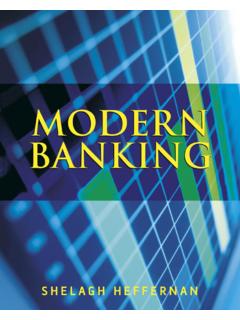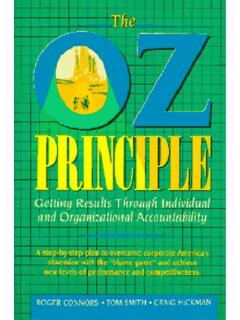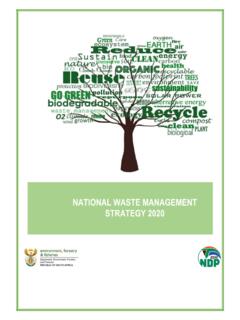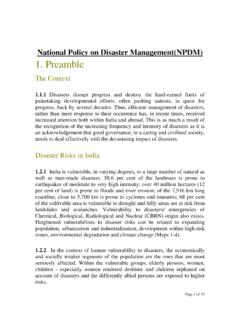Transcription of ISO 14000 Environmental Management Standards
1 ISO 14000 EnvironmentalManagement StandardsEngineering and Financial AspectsALAN S. MORRISD epartment of Automatic Control and Systems Engineering University of Sheffield, UKJohn Wiley & Sons, LtdISO 14000 Environmental Management StandardsISO 14000 EnvironmentalManagement StandardsEngineering and Financial AspectsALAN S. MORRISD epartment of Automatic Control and Systems Engineering University of Sheffield, UKJohn Wiley & Sons, LtdCopyright 2004 John Wiley & Sons Ltd, The Atrium, Southern Gate, Chichester,West Sussex PO19 8SQ, EnglandTelephone (+44) 1243 779777 Email (for orders and customer service enquiries): our Home Page on or Rights Reserved. No part of this publication may be reproduced, stored in a retrieval system ortransmitted in any form or by any means, electronic, mechanical, photocopying, recording, scanning orotherwise, except under the terms of the Copyright, Designs and Patents Act 1988 or under the termsof a licence issued by the Copyright Licensing Agency Ltd, 90 Tottenham Court Road, London W1T4LP, UK, without the permission in writing of the Publisher.
2 Requests to the Publisher should beaddressed to the Permissions Department, John Wiley & Sons Ltd, The Atrium, Southern Gate,Chichester, West Sussex PO19 8SQ, England, or emailed to or faxed to (+44) 1243 publication is designed to provide accurate and authoritative information in regard to the subject matter covered. It is sold on the understanding that the Publisher is not engaged in renderingprofessional services. If professional advice or other expert assistance is required, the services of a competent professional should be Wiley Editorial OfficesJohn Wiley & Sons Inc., 111 River Street, Hoboken, NJ 07030, USAJ ossey-Bass, 989 Market Street, San Francisco, CA 94103-1741, USAW iley-VCH Verlag GmbH, Boschstr. 12, D-69469 Weinheim, GermanyJohn Wiley & Sons Australia Ltd, 33 Park Road, Milton, Queensland 4064, AustraliaJohn Wiley & Sons (Asia) Pte Ltd, 2 Clementi Loop #02-01, Jin Xing Distripark, Singapore 129809 John Wiley & Sons Canada Ltd, 22 Worcester Road, Etobicoke, Ontario, Canada M9W 1L1 Wiley also publishes its books in a variety of electronic formats.
3 Some content that appears in printmay not be available in electronic of Congress Cataloging-in-Publication DataMorris, Alan S., 1948 ISO 14000 Environmental Management Standards : engineering and financial aspects /Alan S. bibliographical references and 0-470-85128-7 (alk. paper)1. ISO 14000 Series Standards . 2. Environmental protection Standards . I. 08 dc222003058345 British Library Cataloguing in Publication DataA catalogue record for this book is available from the British LibraryISBN 0-470-85128-7 Typeset in 10/12pt Times by SNP Best-set Typesetter Ltd., Hong KongPrinted and bound in Great Britain by Antony Rowe Ltd, Chippenham, WiltshireThis book is printed on acid-free paper responsibly manufactured from sustainable forestryin which at least two trees are planted for each one used for paper General approach to developing an Environmental Management Summary of requirements of ISO Other ISO 14000 Engineering aspects of ISO 14001 What is essential and what is not when implementing ISO 14001?
4 11 References122 Design and Implementation of ISO 14001 Environmental Management Design of an Environmental Management Environmental Management system Environmental Management system Environmental Management system ISO 14001 Publicity about good Environmental performance39 Reference393 Measurement Systems in Environmental Choosing suitable measuring Calibration of measuring Documentation of measurement and calibration systems61 References634 Measurement System Random Systematic Error reduction using intelligent Total measurement system errors88 References905 Measurement Signal Conversion, Processing, Transmission and Variable conversion Signal Signal Signal recording1126 Quantification and Effects of Air Air pollution sources and Measurement of air quality: particulate matter Measurement of air quality.
5 Concentration of polluting gaseous products122 References1337 Quantification and Effects of Water Sources and forms of water Consequences of water Water sampling in Testing of river water for pollution139 References1478 Control of Air and Water Air pollution Water pollution control156 References1579 Noise, Vibration and Shock Shock17010 Waste Waste Waste disposal177 References18111 System Reliability and Risk Assessment for Environmental Identifying Risk Risk Risk Reliability References and further reading20112 Statistical Process Conditions for application of statistical process Principles of statistical process XBAR chart (or MEAN chart) CUSUM chart (cumulative sum chart) RANGE chart (R chart) Summary of control charts218 References21813 Monitoring Process Parameter Values to Minimise Pollution Temperature Pressure Flow Level measurement257 References265 Appendix 1 Summary of ISO 14000 Series Standards267 Appendix 2 Typical Structure of an Environmental Management System Manual271 Index283 ContentsviiDedicationTo the memory of Cyril, Joan and is widespread concern about Environmental matters in all developed countriesaround the world, and public interest in this is now so great that the implementationand operation of an efficient and effective Environmental Management system (EMS)is as important to the financial well-being of a company as it is to the environmentthat it is intended to protect.
6 Apart from incurring financial penalties when environ-mental protection legislation is breached, a greater problem that businesses face isthat poor Environmental performance can lead to a boycott of a company s productsand services by customers, with consequential serious damage to its financial extreme cases, the general public may also take direct action that hinders or evenshuts down a company s 14000 is a descriptor for a set of Standards that have been developed inresponse to this global concern about the environment. These Standards represent aconsensus agreement by national Standards bodies around the world about the procedures that need to be followed in establishing an effective EMS. The primarystandard amongst this set is ISO 14001, and the fundamental aim of this book is tocover the procedures that should be implemented by a company in order to satisfythe requirements laid down in this Management to ISO 14001 Standards is of similar importance toquality Management to ISO 9001 Standards in today s businesses, and the linkagebetween the two will be stressed in the text.
7 Apart from the need to satisfy the strin-gent Environmental control legislation that exists in most developed countries, theimage of a company is damaged if pollution incidents occur, particularly if these areidentified by Environmental pressure groups, and this can have a severe impact on the marketability of products and services provided by the company. Conversely,ISO 14001 certification can have a very positive impact on a company s business, inview of the widespread public interest that now exists in Environmental many texts are available that cover the Management considerations in imple-menting Environmental protection procedures that satisfy ISO 14001, these usuallygive little guidance about the necessary engineering procedures that are involved, orthe associated financial implications. This text is intended to fill that gap, and itsprimary aim is therefore to provide a cross-disciplinary approach that bridges themanagement field and the engineering field.
8 The book firstly presents the require-ments of ISO 14001 Environmental Management systems, secondly summarises thecompany Management schemes and procedures required for implementation of ISO14001 systems, and thirdly discusses the engineering considerations and proceduresnecessary to ensure the successful operation of ISO 14001 systems. The relevantfinancial considerations are discussed 1 provides an introduction to the ISO 14000 family of Standards and sum-marises the main requirements of ISO 14001. Comparison with the requirements ofthe quality assurance standard ISO 9001 are also made, with guidance about howcompanies that already have expertise with ISO 9001 can use it beneficially in apply-ing ISO 14001. Particular emphasis is given to the engineering considerations inapplying ISO 14001, in terms of parameter measurement and recording, fault detec-tion, waste reduction, equipment design and provision of emergency response pro-cedures to minimise Environmental damage when faults occur.
9 Comment is also madeabout the need to tailor the EMS to the requirements of each situation and not toincur unnecessary costs in overspecifying the 2 continues on from the brief introduction provided in Chapter 1 andexplains the design and implementation of an ISO 14001 EMS in greater depth. Thefirst section in this chapter covers the general design principles of an EMS. The fol-lowing section then discusses the implementation of an EMS, and is subdivided intothree subsections that cover respectively the general requirements, including therequired level of documentation, the measurement and calibration requirements, and,finally, other engineering issues. The financial costs and benefits of operating an EMSare then discussed and evaluated in Section Following this, the final three sec-tions in this chapter cover, respectively, internal and external EMS auditing proce-dures, the procedure for getting ISO 14001 registration for the system, and adviceabout the need to publicise the Environmental performance in order to maximise thefinancial benefits of operating the largest engineering contribution to the successful operation of an EMS is inthe provision of systems that monitor system performance and measure environ-mental parameters.
10 There is a particular requirement specified in ISO 14001 for theestablishment of good measurement and calibration practices, so that the quality ofmeasurements related to Environmental Management systems can be guaranteed, andproof established that the EMS is successfully ensuring that pollution does not exceeddefined levels of acceptability. Because good measurement practice is so critical tothe success of the EMS, two chapters in the book are devoted to the various aspectsof this. The first of these (Chapter 3) describes the design of measurement systems,and covers the choice of instruments with appropriate characteristics, certified cali-bration procedures, documentation requirements and cost considerations. Followingthis, Chapter 4 considers measurement system errors, and describes procedures toensure that measurements provided as part of an EMS are of adequate quality fortheir intended requirement to maintain accurate records of parameter measurements that are made as part of operating the EMS is also emphasised in ISO 14001, and Chapter 5 discusses the necessary mechanisms for this.










